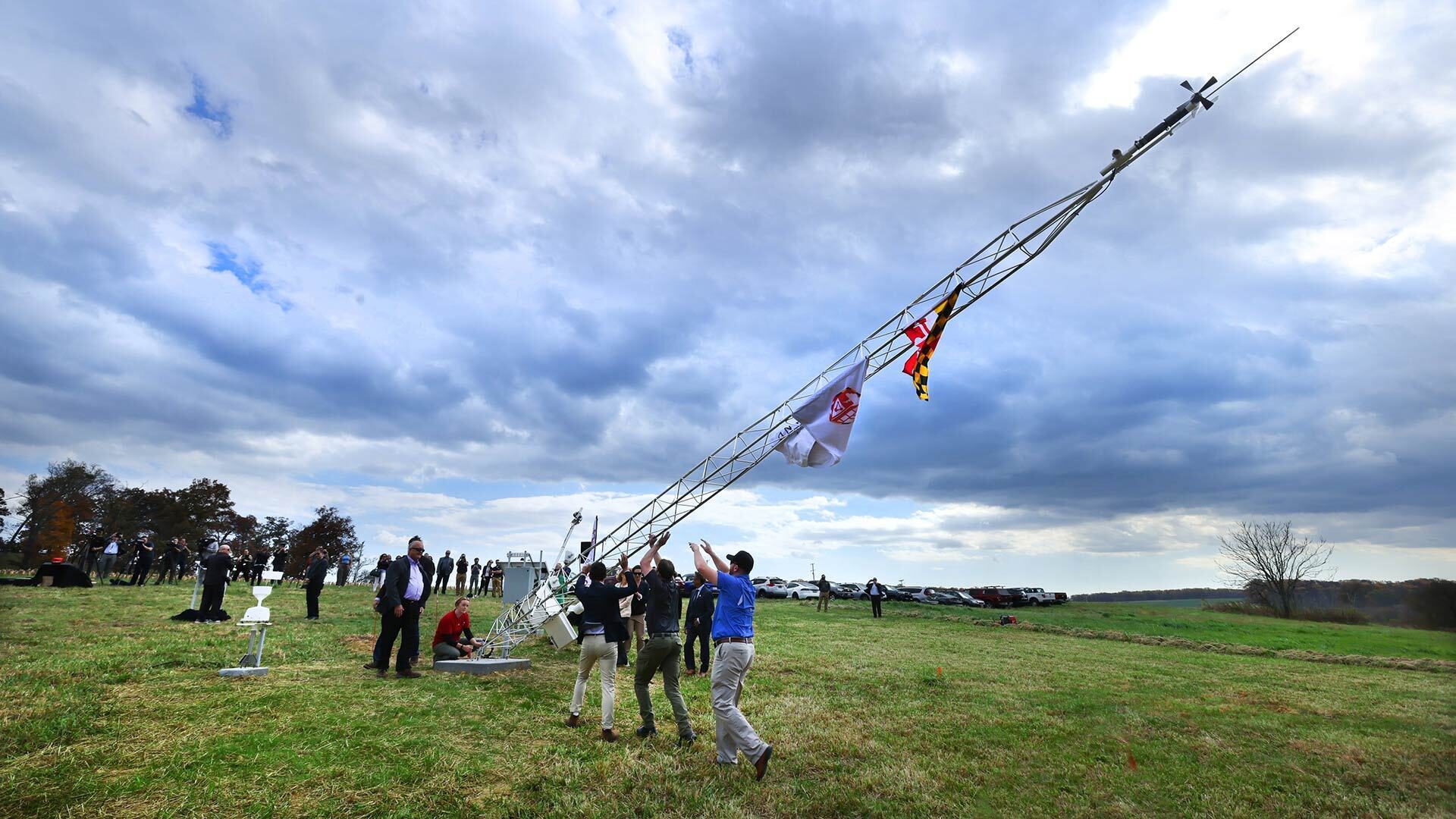- October 31, 2023
- By Maryland Today Staff
University of Maryland and state and federal government officials gathered Monday to hoist a 30-foot tower into place in a farm field near Ellicott City, Md., activating the first piece of a statewide system that will speed early warnings of dangerous weather.
The Maryland Mesonet, a partnership between UMD and the state Department of Emergency Management (MDEM), will feature more than 70 towers dotting the state at approximately 10-mile intervals and is scheduled for completion next year. Every minute, they’ll send local information on temperature, wind, precipitation, soil moisture and more, augmenting National Weather Service data collection and allowing state emergency personnel to stay abreast of rapidly developing storms.
The project was funded with a $4 million state investment announced last year at UMD; at the event Monday, Department of Emergency Management Secretary Russ Strickland said the value of the precise, real-time information the Mesonet will provide can’t be overstated.
“In the coming days, months and years, the Maryland Mesonet will play a vital role in shaping the future of weather prediction, public safety and community resilience,” Strickland said. “I look forward to seeing the positive impact of this project across our state."
The event took place at UMD's Central Maryland Research and Education Center, a College of Agriculture and Natural Resources facility located a few miles west of Ellicott City’s historic downtown. Heavy rains twice in recent years caused violent flash floods that took lives and destroyed buildings in the city.
After the tower was raised and bolted down, Professor Sumant Nigam, leader of the project and chair of UMD’s Department of Atmospheric and Oceanic Science, flipped on the power.
“The Mesonet will protect Marylanders from extreme wind and water harm by advancing emergency preparedness and the accuracy of regional weather forecasts,” he said. “With an active State Climatologist Office and a fully deployed Mesonet soon, the University of Maryland will provide Marylanders insightful information on severe weather and climate variability and change that will benefit the state’s agriculture, tourism and transportation sectors, among others.”
Beyond the system’s benefit for allowing communities to respond more quickly to impending wind and water dangers, Maryland’s farmers will be able to make better decisions on planting and other activities. The system will provide increased information about metrics like soil moisture to State Climatologist Alfredo Ruiz-Barradas, an associate research professor in atmospheric and oceanic science at UMD who provides regular agriculture reports, Nigam said.
The Mesonet is also a component of a project supported by a $3 million Grand Challenges Institutional Grant from UMD. Nigam is one of the initiative's leaders, and part of a campuswide research group helmed by Ellen Williams, Distinguished University Professor of physics and Earth System Science Interdisciplinary Center director. The overall initiative is working to leverage the latest scientific tools (like the Mesonet) and discoveries in various fields to meet the existential threats of climate change in Maryland.
Like the $30 million Grand Challenges Grants program, the Maryland Mesonet is taking proactive steps to solving difficult societal problems—and doing it in the interdisciplinary way demanded by the complexity of those problems, Jennifer King Rice, UMD senior vice president and provost, said at Monday’s event.
“At its core, the Maryland Mesonet project underscores our commitment to create and sustain partnerships that allow our research to have impact locally and globally, and to create solutions for a more equitable, sustainable and resilient world,” Rice said.
Projects such as the Mesonet are prime examples of how the state and flagship university work together for good on projects that benefit all involved, said UMD President Darryll J. Pines.
“As Earth's climate undergoes accelerating changes, weather forecasting only gets tougher. Getting it right quickly is crucial to the safety of people in this region as well as farmers' ability to feed the world,” Pines said. “This state-of-the-art system, coupled with our work with local, state and federal officials, makes our state a better place to live for all Marylanders.”
Amitabh Varshney, dean of UMD’s College of Computer, Mathematical, and Natural Sciences, said the college’s researchers have made great progress on the project in just one year.
“We've reached a milestone today as we turn on the first tower,” he said. “I continue to believe that the Maryland Mesonet will be a force multiplier in weather-related safety and emergency management in the state of Maryland.”
